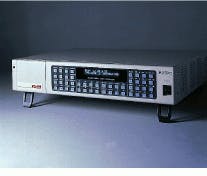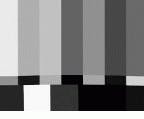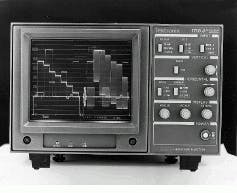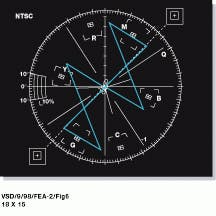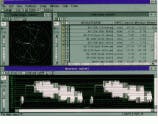OFF-THE-SHELF test equipment QUALIFIES VIDEO systems
OFF-THE-SHELF test equipment QUALIFIES VIDEO systems
By Andrew Wilson, Editor at Large
Many of the standards used in today`s image-processing equipment are based on those developed for broadcast television (TV). Color cameras using NTSC, PAL, or SECAM video outputs are often used as low-cost alternatives in machine-vision systems. For image capture, frame grabbers with higher-resolution S-VHS and RGB inputs are also available from a number of vendors (see "Choosing a frame grabber for vision applications," Vision Systems Design, August 1998, p. 46).
To display images, some frame-grabber and display-controller vendors offer boards with NTSC, PAL, and S-VHS outputs or video pass-through modes. More commonly, however, digital RGB is used as the preferred display standard. To test the signal integrity of these video-based products, manufacturers are turning to a myriad of off-the-shelf pattern generators, waveform monitors, vectorscopes, and video test sets. These products can rapidly analyze such features as color fidelity, gain, frequency response, chrominance, and luminance.
To analyze products that incorporate video-broadcast standards, test systems generally use a signal or pattern generator to produce a set of highly stable video signals with carefully defined characteristics. Using test patterns developed by organizations such as the Society of Motion Picture Television Engineers (SMPTE) and others allows such generators to create standard image signals that can then be displayed and analyzed by a variety of devices that include oscilloscopes, waveform monitors, and vectorscopes.
Pattern generation
For system developers, choosing a pattern generator is the first step in building a video test system. They can choose from hand-held portable devices, add-in PC boards, and stand-alone instruments. All of the generator types deliver various test patterns, including SMPTE color bars, modulated ramp functions, full-field images, and crosshatch functions (see Fig. 1).
Each pattern can be used to test different aspects of the video signal. Using the SMPTE color-bar signal, for example, developers can adjust for color saturation and intensity. Using full-field color bars involves a 100% white IRE (Institute of Radio Engineers) level that is useful for checking the chroma amplitude against the overall video level. Color bars that use a 75% IRE level are used to test the low-frequency response and the quality of video clamping in the imaging system under test.
Pattern generators often feature a modulated-ramp function for testing the operating range of the imaging system. This functional signal can also be used to measure differential gain and analog-to-digital bit errors. Such patterns are also useful for calibrating monitor convergence. For example, by using crosshatch patterns, test engineers can easily align cathode-ray-tube electron guns to ensure correct convergence.
Hand-held or portable test-pattern generators are available from several vendors, including Ozan (Wimborne, Dorset, England), Extron (Anaheim, CA), and Gekco (Issaquah, WA). Featuring color-bar, gray-scale, black-burst, and crosshatch test patterns, Ozan`s Teletest hand-held video-pattern generators also include a mutiburst signal for the frequency testing of video lines. Capable of producing 1-V peak-to-peak composite and S-Video signals, the Teletest generator can be powered either from a 9-V battery or a separate power supply.
Producing both computer-generated VGA (Video Graphics Adapter) signals and NTSC or PAL video signals, the Extron VTG 200 Series of portable video-pattern generators is capable of displaying more than 50 preprogrammed scan formats and 16 test patterns including the SMPTE and Picture Line Up Generating Equipment test charts. The generator can be controlled remotely over an RS-232 line.
Gekco also offers a range of products for video test generation. These products range from a basic version, the Model BB10 that provides an NTSC color black signal, to the MP10, a unit capable of generating multiburst packets, staircase signals, linear ramps, crosshatches, and a test-signal matrix in composite and S-video formats.
Rather than offering portable video generators, some manufacturers are harnessing the power of Windows-based PCs by offering add-in video generator boards to test engineers that can be programmed from a graphical user interface (GUI). For example, GSI (West Chester, PA) offers an ISA (Industry Standard Architecture) based add-in pattern generator board that produces NTSC, PAL, and S-video signals. In operation, the test engineer can select from more than 20 standard test patterns in the Windows environment.
Stand-alone video test-pattern generators are also available. For example, Snell & Wilcox (Sunnyvale, CA) provides the Kudos TPG20 standard-format and hardware-independent test-pattern generator that can be used to deliver PAL, SECAM, and NTSC signals, as well as future expected standards and formats, such as 16:9 HDTV (high-definition television) and PAL-Plus (see Fig. 2). With more than 500 test signals resident in the unit, the generator can also be equipped with the company`s Pattern Master test-pattern software. Using this software, developers can create new line-based patterns for the TPG20, and edit and analyze existing patterns.
Monitor tests
Rather than supply test generators with video outputs, some manufacturers, such as Unigraf Oy (Espoo, Finland) and Team Systems (Santa Clara, CA), have developed test equipment specifically for monitor tests. Using programmable test patterns, such test equipment directly drives the RGB inputs of the monitor under test. Equipment such as the VTG Series of ISA-based add-in boards from Unigraf Oy, for example, contains analog RGB outputs and fully programmable horizontal and vertical timing. The boards are supplied with a built-in set of test patterns that can be augmented with a custom pattern-programming package.
Team Systems also offers a PC add-in board for monitor testing. Dubbed the UNI VG-5000pc series, the ISA-based add-in board delivers pixel-frequency rates of 135, 170, and 220 MHz, as well as full programmability of timings and patterns. Supplied with Windows and DOS software programs, the VG-5000pc can be used to test monitors with horizontal scan rates as high as 165 kHz.
Stand-alone analog RGB test generators for testing high-performance monitors are also available from Team Systems. Featuring dot-clock frequencies from 5 to 400 MHz and horizontal scan rates to 300 kHz, the company`s VG-851 video signal generators can be used to display as many as 11 test patterns, including character, crosshatch, color-bar and gray-scale types (see Fig. 3). In addition, it allows the test engineer to derive special test patterns.
Waveform monitors
Not every detail of a video signal can be seen by examining the image displayed on a monitor. Because of this drawback, test engineers need more specialized test equipment to ensure the integrity of the video output signal obtained from the device under test. Consequently, many test engineers install both waveform monitors and vectorscopes in their test systems. Vectorscopes and waveform monitors complement one another and provide a full representation of all pertinent information about a video signal. Often, both instruments are mounted side-by-side in instrument racks. Some instruments can provide both functions.
By analyzing the waveform monitor display of a color-bar signal, test engineers can measure amplitude and time parameters of the video waveform (see Fig. 4). Because the vertical axis of the waveform monitor graticule is marked in IRE units, the monitor can be used to measure peak-to-peak and other amplitude measurements. The waveform monitor`s horizontal scale is used to measure time intervals of the video signal.
Tektronix (Wilsonville, OR), perhaps the best-known manufacturer of pattern generators, waveform monitors, and vectorscopes, offers its 1710J Series waveform monitors in both NTSC and PAL versions (see Fig. 5). During operation, the 1710J monitor is capable of displaying two synchronous signal waveforms side-by-side. In addition, when used to check one video signal, the monitor can display two different aspects of the waveform, such as full bandwidth and luminance, side by side.
Whereas waveform monitors can measure the amplitude of a video signal, vectorscopes can show the relationship between the chrominance signal and its reference burst (or phase) and gain distortion. For this test, a color-bar signal is used to generate a dot on the vectorscope for each color bar. The position of the dots relative to the targets on the graticule and the phase of the burst vector indicate the gain and phase of the chrominance signal (see Fig. 6).
Combined functions
In the development of its TVM-675, Videotek (Pott stown, PA) combined the functions of a waveform monitor and a vectorscope into one unit. In operation, the unit can display up to three NTSC or PAL composite video signals individually or in combination. Vector displays can also be overlaid for simultaneous observation and comparison of the phase and amplitude of three signals.
Tektronix also offers both stand-alone vectorscopes and combined waveform monitor/ vectorscopes. Its 1740A/ 1750A/1760 series, for example, comprises a family of analog video waveform/vector monitors that can display both NTSC and PAL signals. Using these instruments, test engineers can display multiple signal inputs at the same time, or apply multiple filters to one input for signal analysis. Composite vectorscope functions can demodulate and display the color components of NTSC or PAL signals and the phase and amplitude cursors. An on-screen readout allows the system to reproduce specific chroma values and colors.
Interestingly, such functionality is now available in PC add-in boards. GSI`s Analyst, for example, is an add-in board with software that provides standard waveform and vectorscope monitoring on a PC running under Windows-based software. To use the board, the video output of the device under test is connected to the video input of the Analyst. A triple view of the video signal is then displayed in waveform monitor and vectorscope formats (see Fig. 7).
By using off-the-shelf test equipment, engineers can rapidly ensure that their video-based equipment is within specification. And because much of today`s equipment can be computer-controlled, it is an easy task to set up automated video test equipment stations. In the future, as higher-resolution, digital video standards are introduced by the broadcast market, it is likely they will be endorsed by image-processing vendors. Fortunately, because test-equipment vendors anticipate and readily incorporate these standards, image-processing hardware vendors will have suitable test equipment available when they need it.
FIGURE 1. Using a pattern generator, test engineers can administer color-bar, modulated-ramp, full-field-image, and crosshatch functions to check several video-signal parameters. By using the SMPTE color-bar signal, for example, engineers can adjust color saturation and intensity. (Image courtesy of Ozan)
FIGURE 2. The Snell & Wilcox Kudos TPG20 test-pattern generator can generate PAL, SECAM, and NTSC signals, as well as future expected standards and formats such as 16:9 HDTV and PAL-Plus. Even though it can deliver 500 test signals, the generator can be supplied with company software that allows the creation of new line-based test patterns.
FIGURE 3. Developed specifically for monitor tests, the VG-851 video signal generator from Team Systems can output pixel frequencies from 5 to 400 MHz and horizontal scan rates to 300 kHz. The unit can also display up to 11 test patterns, including character, crosshatch, color-bar, and gray-scale. It also allows test engineers to design new special patterns.
FIGURE 4. By analyzing the waveform monitor display of a color-bar signal, test engineers can measure the amplitude and time parameters of a video waveform. The vertical axis of the waveform monitor graticule is marked in IRE units to allow peak-to-peak and amplitude measurements. The video-signal time intervals can be measured using the monitor`s horizontal scale. (Photos courtesy of Tektronix)
FIGURE 5. The Tektronix 1710J Series waveform monitors are available in both NTSC and PAL versions. They can display two synchronous signal waveforms side by side or two different parts of one waveform side by side.
FIGURE 6. To test the relationship between a video signal`s chrominance and the reference burst (or phase) and gain distortion, a color-bars signal is used to generate a dot on the vectorscope for each color bar. The position of the dots relative to the targets on the graticule and the phase of the burst vector show the gain and phase of the chrominance signal. When the vector dots are rotated with respect to their boxes, the chroma phase error can be measured.
FIGURE 7. After installation in a personal computer, the GSI Analyst add-in board along with proper Windows-based software can provide standard waveform monitor and vectorscope functionality on the computer screen. When the video output signal under test is connected to the Analyst board, a triple view of the video signal can be displayed in monitor and vectorscope formats.
Video test and measurement equipment--a sampling
Burosch Electronic l D-70567 Stuttgart, Germany l (49) 711 1618980 l Fax: (49) 711 1618981 l E-mail: [email protected] l Web: www.burosch.com
CETA Electronic Design l London N11 3LJ, England l (44) 181-368-8110 l Fax: (44) 181-368-9417 l E-mail: [email protected] l Web: www.ced-ceta.demon.co.uk/
Colorado Video l Boulder, CO 80301 l (303) 530-9580 l Fax: (303) 530-9569 l E-mail: [email protected] l Web: www.optics.org/colorado-video/colorado-video.html
Computer & Monitor Maintenance l Norcross GA 30092 l (770) 662-5633 l Fax: (770) 840-8814 l E-mail: [email protected] l Web: www.computermonitor.com/
Extron l Anaheim, CA 92805 l (714) 491-1500 l Fax: (714) 491-1517 l Web: www.extron.com/
Gekco l Issaquah, WA 98027 l (425) 392-0638 l Fax: (425) 392-8227 l Web: www.gekco.com/
GSI l West Chester, PA 19380 l (610) 436-4464 l Fax: (610) 696-6284 l Web: www.videotest.com/
Horita l Mission Viejo, CA 92690 l (949) 489-0240 l Fax: (949) 489-0242 l Web: www.horita.com/
Kenwood Communications l Long Beach, CA 90801 l (800) 950-5005 l Fax: (310) 537-8235 l Web: www.kenwoodtmi.co.jp/e/products/color/cg932.html
Leitch l Chesapeake, VA 23320 l (757) 548-2300 l Fax: (757) 548-4088 l Web: www.leitch.com/
Microvision l Auburn, CA 95603 l (530) 888-8344 l Fax: (530) 888-8349 l Web: www.microvsn.com/options.html#options
Ozan l Wimborne, Dorset BH21 7SA, England l (44) 1202 877270 l Fax: (44) 1202 877271 l Web: www.ozan.co.uk/
Quantum Data l Elgin, IL 60123 l (847) 888-0450 l Fax: (847) 888-2802 l E-mail: [email protected] l Web: www.quantumdata.com/
Rohde & Schwarz l 81671 Munich, Germany l (089) 41 86 95-0 l Fax (089) 40 47 64 l Web: www.rsd.de/
Snell & Wilcox l Sunnyvale, CA 94086 l (408) 260-1000 l Fax: (408) 260-2800 l Web: www.snellwilcox.com/
Team Systems l Santa Clara, CA 95051 l (408) 720-8877 l Fax: (408) 720-9643 l E-mail: [email protected] l Web: www.team-systems.com
Tektronix l Wilsonville, OR 97070 l (503) 682-3411 l Web: www.tek.com/
Unigraf Oy l FIN-02320 Espoo, Finland l (358) 9-802 7641 l Fax: (358) 9-802 6699 l Web: www.unigraf.fi
Videotek l Pottstown, PA 19464 l (610) 327-2292 l Fax: (610) 327-9295 l Web: www.videotek.com/



